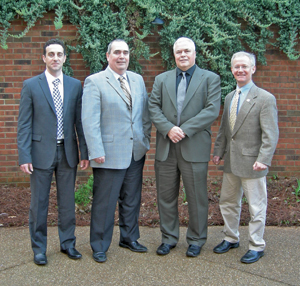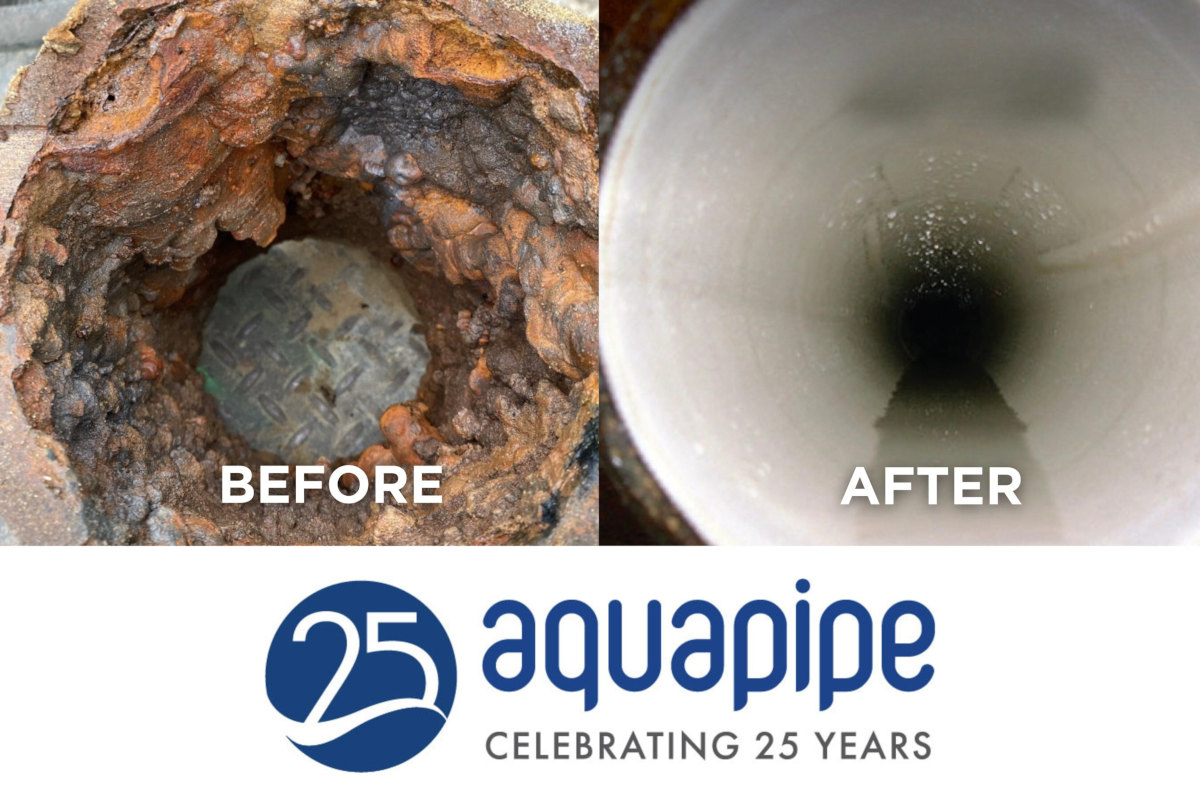2012 Trenchless Technology Editorial Roundtable
May 21, 2012
 Trenchless Rehabilitation of Water Mains
Trenchless Rehabilitation of Water Mains
Over the past decade, there have been a plethora of needs assessments published that document a staggering under-investment in water and sewer infrastructure across North America. This under-investment in many areas has led to pipelines that are failing — or are about to fail.
Trenchless technologies have become a primary tool for repairing these pipes because of their social, economic and environmental benefits. But while trenchless rehabilitation in sewer systems has become commonplace, the use of trenchless techniques in drinking water systems has been slower to catch on, despite its benefits.
To get a better understanding of the trenchless water main rehabilitation market, Trenchless Technology invited a group of industry professionals at the 2012 No-Dig Show to discuss the past, present and future of trenchless for drinking water main rehabilitation.
Roundtable Participants
- George Bontus, P. Eng., Director-Pressure System Applications, Insituform Technologies Ltd., Edmonton, Alberta
- Charlie Zambito, ing., Division Head – Engineering, Urban Planning and Engineering Department, City of Dollard-des-Ormeaux , Quebec
- Paul Pasko, P.E., Principal, Project Manager/Client Service Manager, Short Elliott Hendrickson Inc. (SEH), Minnetonka, Minnesota
- Benoît Côté, M.Sc., Vice President, Aqua-Pipe, Sanexen Environmental Services Inc., Varennes, Quebec
- Jim Rush, moderator and editor of Trenchless Technology.
What is the state of the water mains in United States and Canada? What kind of demand do you see for the use of trenchless techniques in the drinking water sector?
How does trenchless water main rehab compare to open-cut?
George: One thing we don’t have is an even playing field. In the South and other parts of the United States where water mains are shallow – you have 2 to 3 ft of cover – it is pretty tough to beat open-cut. But that is the case where people have to start understanding and realizing that there are other things to consider than just the construction cost. And people are starting to do that. They are starting to embrace the concept of social costs.
Paul: The main point I make when I introduce a community to trenchless technology is its reduced social cost (for example carbon and physical footprints, dust, noise, traffic backups, etc.) compared to dig-and-replace. That is really the main difference between dig-and-replace and trenchless technology. If construction costs are comparable, most communities are more open to using the trenchless option rather than dig-and-replace.
George: We had a case in Victoria, B.C., where they were looking at either open-cut or sliplining. The costs were very similar but using trenchless we were able to finish the job more quickly and with less disruption. People are really starting to appreciate that.
What are the primary techniques you are seeing? Which ones are emerging?
Paul: In the Upper Midwest a lot of larger cities rely on cementitious mortar lining — CML — to rehabilitate their water mains. Some bigger cities even own their own CML installation equipment and will do it themselves. A few of those bigger cities even subcontract their CML installation services to adjacent first-ring suburbs. While we are seeing more pipe bursting and horizontal directional drilling for rehabilitation, first and foremost, cities are still using for dig-and-replace method to rehabilitate their water main pipes.
Ben: I think it is fair to say that municipal engineers who care for water mains are more conservative than sewer engineers, and that explains why some of the trenchless techniques that have existed for quite some time remain fairly marginal compared to open-cut. The preferred choice to rehabilitate water mains is still open-cut. That is what we need to break. Trenchless rehabilitation of water mains is a very small part of what is really going on. When you look at a lot of the water systems, they were built post-World War II, then CML took on in the 1970s as cities began to experience corrosion problems, turning to CML as a corrosion barrier. But now we’ve come to the point where these mains are completely deteriorated and they need to be replaced or rebuilt.
Charlie: In our municipality, we’ve done cement mortar lining and we’ve done epoxy lining. In the last 12 years, we have mostly used CIPP liners. We’ve had good results with the CML and CIPP. I don’t believe that certain technologies are superior to others. You have to evaluate every project and choose the best method available. For a small municipality like us — 50,000 people — CIPP suits us well, but that doesn’t mean that sliplining or pipe bursting is not a good technology. Again, one of the reasons we have stuck with trenchless is our residents. We have all been in situations where you block someone’s driveway or you work in front of someone’s house and they complain. As soon as you have to dig, as soon as you have to disrupt someone’s life, you will hear about it.
What are some of the limiting factors related to trenchless water main rehab?
George: A big issue for municipal engineers and consultants is the uncertainty of the existing pipe condition. Unless you do a very detailed condition assessment where you take samples, you have anecdotal evidence based on comments from your crews or information on break rates. We have worked with a couple of cities where they have done very detailed assessments with different means — some internal and some external investigations — and in those cases they found that the line was in good shape. It was not totally falling apart. In one case it enabled the city to use a semi-structural liner with the capability to span holes and gaps that retained a higher percentage of the capacity vs. other methods.
Paul: Another issue is a lack of standards and consensus about some of the technologies, and that affects the city council members, the directors of public works and the city engineers. If they see plans that are vague or they see non-specific language in an ASTM standard regarding performance testing, they are not going to use it because it still appears unproven. It can be difficult to educate city council members who may not have a technical background and may not fully understand the benefits of using these new technologies. In one situation we invited an NSF representative to speak to the council on what it means for structural liners for water mains to be NSF 61 compliant. That representative did a magnificent job explaining the ins and outs, and assured them that the water will be safe. Those types of resources are available, but I don’t think that they are widely known or used to their full advantage. There are more considerations involved with water main inspection compared to sewer. Is this a limiting factor for water main rehabilitation?
Ben: Most of our clients who have used CIPP for water main rehab don’t have an extensive, comprehensive evaluation of their pipes or didn’t do a pipe condition assessment prior to that. Most people, from what I have seen, look at two things: They look at their water loss — non-revenue water — and they look at their water main break history. A lot of municipalities don’t have accurate drawings and plans of their installations and water mains. Oftentimes they don’t even know when it was put in the ground. Because water mains carry drinking water, because it is a pressure pipe and because they are difficult to access, it is a challenge to have accurate information on the condition of that pipe as opposed to sewer. It is fairly easy to look into a sewer pipe and inspect it, and get a good evaluation of its condition. Another thing with water mains is that you have to shut off the water, and as soon as that happens, the phone starts ringing, even if you’ve told users ahead of time it was going to happen.
Charlie: We do a lot of pressure analysis of our system. I think what municipalities are looking for is more non-destructive methods of assessing the condition of the pipe. There are plenty of destructive methods for accessing a pipe. You can dig down, remove a section of the pipe and send it to the lab for analysis. By doing this, you can get a good idea of the condition of the main. There are also a few non-destructive methods that will give you a good assessment of your pipe. You can never have too much information. We are very hesitant to repave a street before knowing the condition of the underground infrastructure. The last thing you want is a brand new paved street and three months later you have to dig down to repair a break — it just doesn’t look good when you are spending public money. When you buy a new car you won’t buy it with a scratch on it. Who wants to pay for a newly paved street with a patch in it?
Paul: In the Upper Midwest, water main pipe condition assessment is starting to gather momentum. Today, I am not unaware of many cases where communities use anything other than indirect information — chiefly break history — to measure the existing condition of their pipes, but that is changing. As an engineer, I need more accurate information or I cannot give reasonable answers to a city council as to whether or not we should cut up the streets to rehabilitate their water main. Without this evidence, I am finding increasingly that mayors and councils will err on the side of caution from a cost standpoint and not rehabilitate their water main pipe.
George: Globally water rehabilitation has been reactive, not proactive. The place where you see people are being more proactive is where you don’t want to dig up the street. One municipality I work with has a three-year, no-dig policy. If you pave the street, you don’t dig it for three years. In cases like this, it is important that you collect as much information as possible.
How do regulations affect the trenchless water main rehabilitation market?
George: The biggest thing is the pipe has to have NSF certification. But then you still have some cities that just don’t want any chemical curing just because of the stigma that has been around for many years with different types of chemical products. But I don’t see that as being a real limiting factor. There are some issues regarding temporary water systems. It’s not like you are setting up a bypass and going manhole to manhole. Basically, you are providing another water system in the interim so there are a lot of different requirements related to disinfection and public health.
Ben: The main criterion: safety — safety as it relates to the quality of the drinking water. Fortunately, the NSF certification reassures most people as to the safety of the drinking water. But even though our product is NSF certified, we still find areas where we may need to get state EPA approval on top of NSF certification. But there are other issues that help the trenchless option. One is AC (asbestos-cement) pipe – that pipe now is really becoming a problem. We see it a lot in the Southwest United States and in Alaska. What do you do with an AC pipe that is past its useful life? That actually plays to the advantage of trenchless because you don’t want to dig it up. You don’t want to touch it. Another consideration I see more and more in built-up areas, downtown cores and industrial areas is contaminated soil. When you are addressing the problems of your aging pipe, the immediate reflex is to dig and replace. But when you are in an area with contaminated soil, that is a very big problem. Again it plays to the advantage of trenchless because you are digging access pits instead of opening up a trench. Although, as a product vendor, I still have to prove that my product will resist the contamination in the soil. Lastly, the issue of greenhouse gas emissions is becoming an important subject, and that plays in great favor of the trenchless industry. We have done the calculations of the greenhouse gas savings when you do a CIPP rehab of a water main as opposed to open cut, and you actually reduce GHG by over 80 percent when using CIPP. That is another incentive to go with trenchless technologies. So all in all, environmental factors play in our favor in trenchless as opposed to against us.
Paul: One issue we see in the Upper Midwest is pressure testing regulations — that has been a big deal. For many years, people have been using AWWA standard C600 for pressure testing pipe, which calls for 150 psi for a minimum of two hours. But when you rehabilitate using a structural liner, you can end up pressure testing against with old line valves, curb stops and other aging infrastructure, and can blow that older equipment apart by pressure testing according to C600. Some utility superintendents do not want to exercise the curb stop because they are concerned it will come apart during exercising. There’s no way they are going to want to put that much pressure against remaining equipment in that condition. So there is a lack of information on how to test composite liners inside a host pipe. And as a result, some cities are reluctant to go out on a limb … they don’t want to be the first ones to figure out pressure testing in their state. In addition, some state regulators are not sure what guidance to give, so they put the onus back on the city. And if the regulators aren’t sure, how can I convince my city council to spend the money?
George: You have to do some form of pressure test, but you don’t know what effect that will have on the existing infrastructure. If you are putting in a fully structural lining, the liner is going to survive, it’s just a matter of what is going to happen to the connections. In some cases, if you pressure test too high, you can damage the host pipe.
Charlie: Pressure testing at 150 psi — or in our case 125 psi — is for new systems with new services lines. What we do with CIPP is we test the liner at 125 psi before we open our services to make sure that there are no leaks. When we test with our services open, we’ll test it at 70 psi. We don’t need to test our existing service lines that have been there for 40 or 50 years at 125 psi. There is no need for it. A lot of the regulations were done for replacement or new construction. I think the major thing is water quality. That’s the thing that everyone wants to be reassured of — that the quality of the water is good.
It seems that a lot of communities are learning the same lessons independently. What is being done
to help share information?
George: There is still a need for education. It starts with just telling people there are technologies available and it piques their interest. And as you move forward, you run into all the other questions and temporary road blocks. It takes a while. I think it is a fair comment and observation that when you bring a new technology in, it’s going to be two years before you get a job, before they will look at it. That’s what we are seeing all over the place, especially in the water systems.
Ben: It takes years from the day you start working with a client on establishing a project and getting the first job in the ground because there is a blank in our industry when it comes to water main rehabilitation. The sewer rehab industry is more mature with standards that support it but none of that exists in the drinking water industry. There are no real standards to design a water main rehabilitation project. No real standards exist to establish how to perform the work or how to test the product. I think it will still be a couple of years before this industry has matured enough to the point where city engineers and consulting engineers can actually reference proper standards to rely on for trenchless rehabilitation.
George: One of the biggest problems we face in the cured-in-place sector is that it is a very inconsistent message that people are getting. They are not getting the same information everywhere. A municipal owner may be getting different facts from vendors and consulting engineers and makes them hesitant to use new technology. So that is something that can be overcome by having the proper standards, and making everyone aware of the standards. And that is part of the education process.
Paul: We do our part to share information about trenchless technology by using our company’s 80-year history. In other words, we have been dealing with municipalities in the Upper Midwest for long time and have forged a solid reputation with them. When those municipalities see our 80-year-old firm accepting trenchless technology and educating them about it, they are usually more receptive to it. At the end of the day, it is about relationships and trust.
George: I think we need the recognized industry leaders to step up — AWWA, ASTM, APWA, EPA. Those are the organizations we really need to help with leading the charge. They are the ones that write the regulations. They are the ones that everybody looks to for guidance.
Charlie: We also need to promote our success stories. People are hesitant to try something new, to be the first one. The products and technologies are available and work. If you get the message out that these products are working elsewhere, people will be less hesitant to try them.
Ben: People are starting to get less and less hesitant. If you look at Canada, for example, the engineering community has pretty much come to a consensus that using trenchless CIPP for water mains is acceptable. The industry and the municipalities have come together in establishing the standards, and CIPP for water main rehab has become just like sewer rehab elsewhere. But each year we see more acceptance.
Paul: We have done a lot of outreach with some of the rural water associations where we will invite people to a lunch-and-learn and then visit a jobsite to see a contractor put a couple shots of liner into host water main pipes. We did the same thing with pipe bursting. That outreach does a lot to dispel some of the doubts and fears about trenchless.
How much of a factor is cost in the trenchless vs. open-cut comparison?
Paul: Cost is a factor. On the past couple jobs where we used CIPP lining, it was 5 to 10 percent less cost compared to dig-and-replace. We write bid documents open ended enough to attract multiple bidders and multiple products to help ensure competition, and that is also helpful. Really the icing on the cake is the greenhouse gas emissions reduction you get with trenchless. In some of the cities we serve, there are ordinances on the books that you can’t even idle a truck because of greenhouse gas emission restrictions. And that is true relative to pipe bursting as well. A few years ago the pipe bursting was as much as 20 percent less than the cost to dig-and-replace. And by doing the pipe bursting we are able to save trees. In one case, a city mandated that no trees could be taken down, and in that case trenchless was the only option.
Charlie: It is difficult to compare trenchless and open-cut because they are so very different. We have seen that the costs are very comparable when not taking into consideration the social cost. Like Paul said, that is like the icing on the cake. With the price of oil just rising and the cost of asphalt also rising, this makes open-cut replacement more expensive due to street restoration costs. So, I don’t see trenchless being more expensive than open-cut in the future. Even though open-cut and trenchless may be similar in terms of pure cost, depending on the particulars of a job and on how hungry a contractor is at bid time, if you factor in the social cost, trenchless is definitely cheaper that open-cut.
Paul: Charlie’s point on the price of asphalt, I think that is going to push the movement for more accurate water main condition assessments in the United States. Too often I see communities reach for a tool like dig-and-replace for an entire neighborhood when they really didn’t need to because maybe only a few pipe shots needed rehabilitation. But with the price of oil impacting the cost of street replacement, I think communities will have to make even more informed decisions about not just how much of their water main needs rehabilitating, but also whether or not to rehabilitate using dig-and-replace.
Ben: There are two different scenarios. In heavily built up urban areas, there are definitely big savings to be made using trenchless. These are in downtown cores, areas where you have a lot of concrete slab streets that are costly to restore. In residential areas, trenchless and open-cut are close in price, but it is the other social advantages that weigh in favor of trenchless. As a manufacturer and installer, cost is a very big factor. We are working all the time in trying to reduce those costs because we understood from the beginning that our competition was open-cut. We had to beat that with the cost because at the end of the day, especially when you are developing a new market, we are in direct competition with open-cut. While we have been able to be competitive with open-cut in residential areas, in built up urban areas, trenchless is cheaper than open-cut.
George: The big consideration is that the decision on whether to use trenchless or open-cut depends on the setting. If you try to push the trenchless product just because you want to do it in a situation where it is not going to be the best fit, nobody is going to be happy. One of the things that is going to drive the cost is the feasibility of doing the trenchless method and the risks. The more you know about the pipe, the less risk there is. We worked the rehab of a 20-in. steel water main recently where the consultant on the job told us that we were between 50 to 60 percent of the cost of a similar open-cut project in the area.. And we were able to do it in a considerably shorter time frame. Some clients are really starting to embrace social cost and use a triple-bottom-line approach to evaluate big capital projects. They look at the social, environmental and financial aspects. One project we bid was set up on a point system where one of the criteria was the impact on trees in the neighborhood. In that case, lining was the second lowest cost to install, but it was selected because it scored better due to its environmental and social benefits. We are seeing more of this type of approach from informed owner were the lowest bid is not the sole factor in awarding a contract.
Paul: In rural areas of the Upper Midwest, it is more difficult to implement trenchless technologies unless the pipe needing rehabilitation crosses beneath a railroad track, is under a main street that impacts business owners, etc. While the reason for the difficulty can be cost, sometimes the difficulty is also because local dig and replace contractors view trenchless technology as taking work away from them and giving it to an out of state contractor that can afford the specialized equipment needed to rehabilitate a pipe using trenchless technology. We had a project delayed a year because a local contractors argued with the city council over awarding a project to a contractor that is viewed as an outsider. The engineering is easy; sometimes the politics can be tough.

 Trenchless Rehabilitation of Water Mains
Trenchless Rehabilitation of Water Mains






